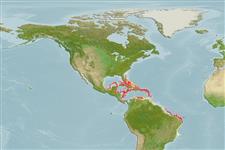>
Tetraodontiformes (Puffers and filefishes) >
Triacanthodidae (Spikefishes) > Triacanthodinae
Eponymy: Eldridge Reeves Fenimore Johnson (1899–1986) was a financier and philanthropist and a Trustee of the Academy of Natural Sciences of Philadelphia. [...] (Ref. 128868), visit book page.
More on author: Myers.
Environment: milieu / climate zone / depth range / distribution range
Ecologia
marino demersale; distribuzione batimetrica 183 - 549 m (Ref. 58018). Tropical
Western Central Atlantic: Bahamas to Greater and Lesser Antilles and western Caribbean Sea.
Size / Peso / Age
Maturity: Lm ? range ? - ? cm
Max length : 1.3 cm NG maschio/sesso non determinato; (Ref. 46892)
Life cycle and mating behavior
Maturità | Riproduzione | Deposizione | Uova | Fecundity | Larve
Claro, R., 1994. Características generales de la ictiofauna. p. 55-70. In R. Claro (ed.) Ecología de los peces marinos de Cuba. Instituto de Oceanología Academia de Ciencias de Cuba and Centro de Investigaciones de Quintana Roo. (Ref. 26340)
IUCN Red List Status (Ref. 130435: Version 2024-1)
Threat to humans
Harmless
Human uses
Strumenti
Special reports
Download XML
Fonti Internet
Estimates based on models
Preferred temperature (Ref.
123201): 11 - 19.5, mean 15.6 °C (based on 52 cells).
Phylogenetic diversity index (Ref.
82804): PD
50 = 1.0000 [Uniqueness, from 0.5 = low to 2.0 = high].
Bayesian length-weight: a=0.01995 (0.00906 - 0.04395), b=3.01 (2.83 - 3.19), in cm total length, based on all LWR estimates for this body shape (Ref.
93245).
Trophic level (Ref.
69278): 4.3 ±0.8 se; based on size and trophs of closest relatives
Fishing Vulnerability (Ref.
59153): Low vulnerability (10 of 100).
